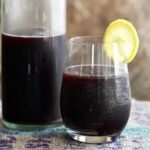Simple Fruit Juice Cider
It’s easy to make cider from a bottle of fruit juice. This simple recipe results in a sweet and sparkling hard cider that is so much better than Grandpa’s hooch. All you need is a bottle of juice and a packet of yeast!
- Prep Time: 10 minutes
- Total Time: 10 minutes
- Yield: 1 gallon 1x
- Category: Beverage
- Method: Fermented
- Cuisine: American
- Diet: Gluten Free
Ingredients
Units
Scale
- 1 gallon of 100% clear fruit juice (preservative-free)
- 1/4 tsp champagne yeast (1/4 package)
- 3 Tbsp sugar (optional, see notes)
Instructions
- Pour 2 oz of juice out of the bottle (to prevent overflow during fermentation).
- Follow the instructions of the packet of yeast and add it to the juice jug. (Some require prehydrating, others can be added right away).
- Add the sugar, then cap the bottle with an airlock. Agitate the bottle slightly to make sure the yeast is mixed in. (See the section above for advice about using a balloon instead of an airlock).
- Place the bottle somewhere dark to ferment for 3 to 5 days. A closet or a kitchen cupboard is perfect.
- After 5 days the bubbling in the airlock should have slowed down.
- Remove the airlock and replace the original cap. Alternatively, bottle the cider for proper carbonation. See the section above for details on how to bottle homemade cider.
- Store the jar in the fridge to finish fermenting.
- Every few days open the cap to release the build-up of pressure in the bottle. The cider is finished when it is sparkling. The cider will become less sweet and more alcoholic as time goes on. So taste it every 2-3 days, and enjoy it when the flavor is to your liking.
Notes
- Choose clear fruit juices, like grape, apple, or pear. Don’t try this recipe with orange juice or pineapple juice because these juices cause the yeast to become stringy and unappetizing.
- Without any added sugar, the maximum alcohol content of most juices is around 3-6%. Adding sugar increases the potential alcohol content. For example, adding 3 Tbsp of sugar will increase the alcohol levels to around 5-10%. However, the original sugar content of your juice will also make a difference. The best way to determine how much sugar to add is to use a hydrometer to measure potential alcohol content.
- If you don’t add sugar, cap the juice after 3 days to ensure you have enough natural sugars to carbonate the drink. Otherwise, let it ferment for 5 days.
- If you want a dry, wine-like beverage, keep fermenting until the airlock stops bubbling. The resulting beverage won’t be sweet or carbonated.
- I haven’t provided nutritional information for this recipe because it will depend on the type of juice and how long it is fermented. Homemade cider will range from very sweet, not at all sweet depending on when you decide to drink it.
Find it online: https://www.fermentingforfoodies.com/homemade-fruit-juice-cider/
